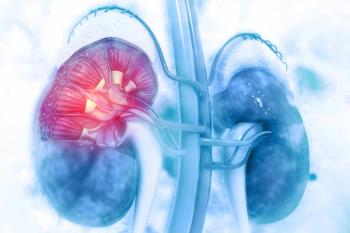
BAP1 Independent Marker of Outcomes for Low-Risk RCC
Expression of BAP1 could help identify which clear-cell renal cell carcinoma patients diagnosed with low-risk disease are the most likely to progress.
Expression of BAP1, or BRCA1 associated protein-1, was an independent prognostic marker in patients initially diagnosed with low-risk clear-cell renal cell carcinoma (ccRCC), according to an immunohistochemistry
About 5% of patients diagnosed with low-risk ccRCC will go on to develop metastatic disease and die from the disease. Until recently, researchers have lacked a biomarker that could help to identify which patients diagnosed with low-risk disease are the most likely to progress.
“The use of molecular genetics to identify patients with low-risk ccRCC who are actually at risk of ccRCC death following surgery has the ability to change the field by not only providing a useful prognostic marker but also a potential therapeutic target in the adjuvant setting,” wrote Richard W. Joseph, MD, assistant professor at the Mayo Clinic, Jacksonville, Fla., and colleagues in Cancer.
Joseph and colleagues developed a cost-effective, sensitive, and specific immunohistochemistry assay to detect BAP1 expression and used it to determine if BAP1 expression is associated with risk of ccRCC death. The study included 1,479 patients who underwent nephrectomy for localized ccRCC and were classified as either BAP1-negative or BAP1-positive.
The researchers were able to successfully stain BAP1 in 98.3% of enrolled patients. An additional 44 samples were excluded for inadequate follow-up. Of the 1,410 useable samples, 10.5% were classified as BAP1 negative, 84.8% were BAP1 positive, and 4.7% were considered unclear.
At a median follow-up of 8.3 years, 1,092 patients were alive; 252 patients had ccRCC specific deaths. Data indicated that patients with BAP1-negative tumors had a threefold increased risk for RCC specific death compared with BAP1-positive tumors (HR = 3.06; 95% CI, 2.28-4.10).
“Our data suggest that BAP1 identifies the most aggressive forms of ccRCC (even among those with low-risk tumors) and as such, we advocate for the use of BAP1 staining to better inform postsurgical management for patients with clinically localized ccRCC,” the researchers wrote.
Multivariate analysis showed that BAP1 expression remained an independent marker of prognosis after adjusting for the UCLA integrated staging system (HR = 1.67; 95% CI, 1.24-2.25). In addition, BAP1 was also a prognostic marker in patients with Mayo Clinic stage, size, grade, and necrosis score of 3 or less (HR = 3.24; 95% CI, 1.26-8.33).
“Given the relatively low cost and reproducibility of this immunohistochemistry assay, this test has the potential to offer a straightforward affordable screening tool to identify ccRCC tumors with a more aggressive behavior,” the researchers wrote.
Newsletter
Stay up to date on recent advances in the multidisciplinary approach to cancer.

















































































